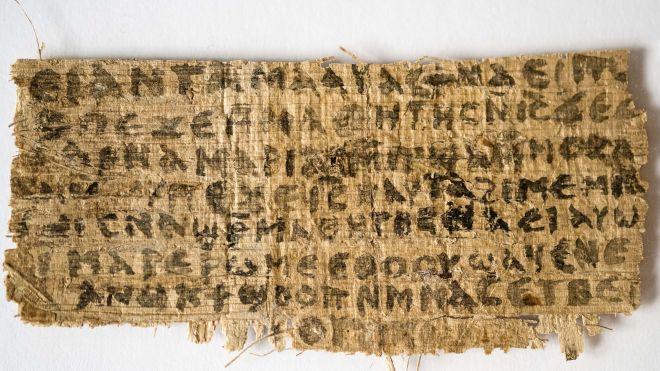 Remember that front page New York Times story about Jesus' wife? Yeah, about that ...
Well, earlier this month we learned from WBRZ:
Remember that front page New York Times story about Jesus' wife? Yeah, about that ...
Well, earlier this month we learned from WBRZ:
The Smithsonian Channel says the premiere of its documentary on a papyrus fragment that purports to show Jesus referring to his wife is being delayed until further tests can be done.
And another scholar has noted that the fragment that was the basis for the story somehow managed to replicate a typo from an internet site related to the Gospel of Thomas. Many folks had noted that the fragment seemed to borrow from the Gospel of Thomas but Michael Grondin noted the similarities a typo in his Interlinear Coptic-English Translation of the Gospel of Thomas.
In the first and third paragraphs of that New York Times story, we learned about the scholar who was making the claim about the Jesus' fragment:
A historian of early Christianity at Harvard Divinity School has identified a scrap of papyrus that she says was written in Coptic in the fourth century and contains a phrase never seen in any piece of Scripture: “Jesus said to them, ‘My wife ...’ ”
The finding was made public in Rome on Tuesday at the International Congress of Coptic Studies by Karen L. King, a historian who has published several books about new Gospel discoveries and is the first woman to hold the nation’s oldest endowed chair, the Hollis professor of divinity.
So after the front-page treatment about Jesus' wife, have you seen much coverage of the rest of the story? Of course not.
And yet all of the fallout has been more than a bit embarrassing for such an august scholar.
The Chronicle of Higher Education decided to ask her about it. That is a great idea for a story:
I talked to King recently about the reaction to the fragment. She said that while she was braced for some vigorous discussion, the avalanche of attention and criticism was much more than she expected. It has included angry, hateful e-mails (“pretty ugly and unprintable,” she says). The reaction from scholars has influenced her thinking, and she plans to incorporate some of their analyses into her paper on the fragment, which is slated to be published in the Harvard Theological Review in January, assuming that the ink test now being performed doesn’t reveal the fragment to be a modern forgery.
Sometimes I wish I could show people the contents of my email inbox. Anyway, he asks her why she didn't wait for the ink test to be done. She gives a response. The article ends:
But how do you roll out a potential blockbuster discovery like this? King said she’s been asking colleagues how they would have handled it differently, and they’ve reassured her that they would have done what she did. And while she’s been dinged by some for jumping the gun, others would have attacked her for keeping it to herself. “The longer I held back, the more criticism there would have been,” she said.
One thing she would change? The title of the fragment. Calling it “The Gospel of Jesus’ Wife” seemed natural. And for scholars like King, one of the authors of a book about The Gospel of Judas, alternative accounts of the Jesus story are not shocking. She misjudged just how inflammatory that title would turn out to be. She’s been asking around for ideas on a new, less exciting name.
Great idea for a follow-up but why rely on just King here? So a Harvard prof asked her Harvard colleagues and they all told her she was just fine? Is that really that interesting? And we're not able to find any critics to add insight into how she messed up her big, splashy, New York Times, Smithsonian Channel reveal based around the title she chose? Really?
I mean, these regular "shake the foundations of Christianity" stories in the media are getting embarrassing. You'd think that there would be some much tougher questions of the scholars who were relied on, no? And on that note, come back later for a devastating look at what those early stories about this fragment missed.
